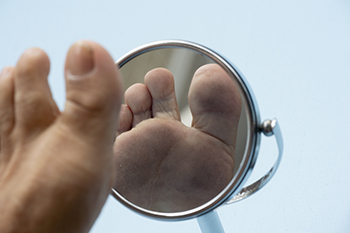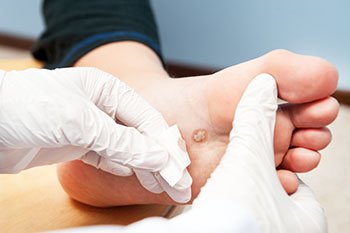Items filtered by date: August 2021
The Importance of Proper Foot Care for Diabetic Patients
 Diabetic foot ulcers (DFUs) are wounds that can form on the feet of people with diabetes. Due to the combination of diabetic neuropathy and poor circulation that many people with diabetes experience, these wounds can often go undetected in their early stages and tend to heal slowly and poorly. The more severe the wound, and the longer it remains untreated, the more likely it is that there will be complications. Early detection and treatment of these wounds is crucial to the overall health of a person with diabetes. Daily visual inspections of your feet can be done at home as a preventive measure to check for any abnormalities or changes in the appearance of your feet. Take note of any cuts, scrapes, sores, discoloration, or strange sensations like pain, numbness, or tingling. If you notice anything unusual, it is suggested that you schedule an appointment with a podiatrist as soon as possible.
Diabetic foot ulcers (DFUs) are wounds that can form on the feet of people with diabetes. Due to the combination of diabetic neuropathy and poor circulation that many people with diabetes experience, these wounds can often go undetected in their early stages and tend to heal slowly and poorly. The more severe the wound, and the longer it remains untreated, the more likely it is that there will be complications. Early detection and treatment of these wounds is crucial to the overall health of a person with diabetes. Daily visual inspections of your feet can be done at home as a preventive measure to check for any abnormalities or changes in the appearance of your feet. Take note of any cuts, scrapes, sores, discoloration, or strange sensations like pain, numbness, or tingling. If you notice anything unusual, it is suggested that you schedule an appointment with a podiatrist as soon as possible.
Wound care is an important part in dealing with diabetes. If you have diabetes and a foot wound or would like more information about wound care for diabetics, consult with one of the chiropodists from Complete Family Footcare & Therapy. Our clinicians will assess your condition and provide you with quality foot and ankle treatment.
What Is Wound Care?
Wound care is the practice of taking proper care of a wound. This can range from the smallest to the largest of wounds. While everyone can benefit from proper wound care, it is much more important for diabetics. Diabetics often suffer from poor blood circulation which causes wounds to heal much slower than they would in a non-diabetic.
What Is the Importance of Wound Care?
While it may not seem apparent with small ulcers on the foot, for diabetics, any size ulcer can become infected. Diabetics often also suffer from neuropathy, or nerve loss. This means they might not even feel when they have an ulcer on their foot. If the wound becomes severely infected, amputation may be necessary. Therefore, it is of the upmost importance to properly care for any and all foot wounds.
How to Care for Wounds
The best way to care for foot wounds is to prevent them. For diabetics, this means daily inspections of the feet for any signs of abnormalities or ulcers. It is also recommended to see a podiatrist several times a year for a foot inspection. If you do have an ulcer, run the wound under water to clear dirt from the wound; then apply antibiotic ointment to the wound and cover with a bandage. Bandages should be changed daily and keeping pressure off the wound is smart. It is advised to see a podiatrist, who can keep an eye on it.
If you have any questions, please feel free to contact our offices located in North York and Mississauga, ON . We offer the newest diagnostic and treatment technologies for all your foot care needs.
What Is a Plantar Wart?
 Common warts that form on the bottom of the foot are known as plantar warts. Plantar warts form because of the human papillomavirus, (also known as HPV) which tends to thrive in warm and moist environments like locker rooms, shower floors, and swimming pools. Common signs that the skin growth on the foot is a plantar wart include the growth being raised, feeling hard, having a rough surface, or possibly having small black dots near the center. Plantar warts may also be painful when standing or applying pressure to the wart. While many warts eventually go away on their own, plantar warts that persist should be looked at by a physician. Patients with diabetes, circulatory problems, or vascular disease should also have their plantar warts checked by a physician.
Common warts that form on the bottom of the foot are known as plantar warts. Plantar warts form because of the human papillomavirus, (also known as HPV) which tends to thrive in warm and moist environments like locker rooms, shower floors, and swimming pools. Common signs that the skin growth on the foot is a plantar wart include the growth being raised, feeling hard, having a rough surface, or possibly having small black dots near the center. Plantar warts may also be painful when standing or applying pressure to the wart. While many warts eventually go away on their own, plantar warts that persist should be looked at by a physician. Patients with diabetes, circulatory problems, or vascular disease should also have their plantar warts checked by a physician.
Plantar warts can be very uncomfortable. If you are seeking treatment, contact one of our chiropodists from Complete Family Footcare & Therapy. Our physicians will treat your foot and ankle needs.
About Plantar Warts
Plantar warts are the result of HPV, or human papillomavirus, getting into open wounds on the feet. They are mostly found on the heels or balls of the feet.
While plantar warts are generally harmless, those experiencing excessive pain or those suffering from diabetes or a compromised immune system require immediate medical care. Plantar warts are easily diagnosed, usually through scraping off a bit of rough skin or by getting a biopsy.
Symptoms
- Lesions on the bottom of your feet, usually rough and grainy
- Hard or thick callused spots
- Wart seeds, which are small, clotted blood vessels that look like little black spots
- Pain, discomfort, or tenderness of your feet when walking or standing
Treatment
- Freezing
- Electric tool removal
- Laser Treatment
- Topical Creams (prescription only)
- Over-the-counter medications
To help prevent developing plantar warts, avoid walking barefoot over abrasive surfaces that can cause cuts or wounds for HPV to get into. Avoiding direct contact with other warts, as well as not picking or rubbing existing warts, can help prevent the further spread of plantar warts. However, if you think you have developed plantar warts, speak to your chiropodist. He or she can diagnose warts on your feet and recommend the appropriate treatment options.
If you have any questions, please feel free to contact our offices located in North York and Mississauga, ON. We offer the newest diagnostic and treatment technologies for all your foot care needs.
Be Mindful Of Your Feet While Wearing Flip-Flops This Summer
Different Stages of Gout
Gout is a type of arthritis caused by excess uric acid in the bloodstream. This acid can crystallize in the joints and cause symptoms like inflammation, swelling, stiffness, and pain. Gout can affect any joint, but frequently affects the joints of the big toe. Gout can progress into several stages. The first stage is asymptomatic hyperuricemia in which uric acid levels in the blood are elevated but do not cause any noticeable symptoms, although they may cause silent tissue damage. In the acute stage, sudden, painful gout flare ups that last between three days and two weeks can arise. The period between gout attacks is called the interval or intercritical period. If you suffer from gout it is suggested that you seek the care of a podiatrist.
Gout is a painful condition that can be treated. If you are seeking treatment, contact one of the chiropodists from Complete Family Footcare & Therapy. Our clinicians will treat your foot and ankle needs.
What Is Gout?
Gout is a form of arthritis that is characterized by sudden, severe attacks of pain, redness, and tenderness in the joints. The condition usually affects the joint at the base of the big toe. A gout attack can occur at any random time, such as the middle of the night while you are asleep.
Symptoms
- Intense Joint Pain - Usually around the large joint of your big toe, and it most severe within the first four to twelve hours
- Lingering Discomfort - Joint discomfort may last from a few days to a few weeks
- Inflammation and Redness -Affected joints may become swollen, tender, warm and red
- Limited Range of Motion - May experience a decrease in joint mobility
Risk Factors
- Genetics - If family members have gout, you’re more likely to have it
- Medications - Diuretic medications can raise uric acid levels
- Gender/Age - Gout is more common in men until the age of 60. It is believed that estrogen protects women until that point
- Diet - Eating red meat and shellfish increases your risk
- Alcohol - Having more than two alcoholic drinks per day increases your risk
- Obesity - Obese people are at a higher risk for gout
Prior to visiting your podiatrist to receive treatment for gout, there are a few things you should do beforehand. If you have gout you should write down your symptoms--including when they started and how often you experience them, important medical information you may have, and any questions you may have. Writing down these three things will help your podiatrist in assessing your specific situation so that he or she may provide the best route of treatment for you.
If you have any questions, please feel free to contact our offices located in North York and Mississauga, ON . We offer the newest diagnostic and treatment technologies for all your foot care needs.
What Causes Ingrown Toenails?
 When a toenail curves at the sides and grows down into the surrounding skin, an ingrown toenail can form. This causes the toenail to dig deep into the skin resulting in pain, redness, and swelling in the affected area. Common methods that are used to prevent ingrown toenails can include wearing shoes and socks that allow enough room for the toes to move freely, keeping the feet clean and dry, and cutting the toenails straight across but not too short. Ingrown toenails may develop due to trauma, a fungal infection, psoriasis, or pressure that is applied on the nailbed from certain athletic activities. Other risk factors can include diabetes, circulation problems, or numbness in the toes. If you have an ingrown toenail that is persistent or looks infected, visiting a podiatrist can be extremely beneficial for your foot health.
When a toenail curves at the sides and grows down into the surrounding skin, an ingrown toenail can form. This causes the toenail to dig deep into the skin resulting in pain, redness, and swelling in the affected area. Common methods that are used to prevent ingrown toenails can include wearing shoes and socks that allow enough room for the toes to move freely, keeping the feet clean and dry, and cutting the toenails straight across but not too short. Ingrown toenails may develop due to trauma, a fungal infection, psoriasis, or pressure that is applied on the nailbed from certain athletic activities. Other risk factors can include diabetes, circulation problems, or numbness in the toes. If you have an ingrown toenail that is persistent or looks infected, visiting a podiatrist can be extremely beneficial for your foot health.
Ingrown toenails can become painful if they are not treated properly. For more information about ingrown toenails, contact one of the chiropodists of Complete Family Footcare & Therapy. Our clinicians can provide the care you need to keep you pain-free and on your feet.
Ingrown Toenails
Ingrown toenails occur when a toenail grows sideways into the bed of the nail, causing pain, swelling, and possibly infection.
Causes
- Bacterial infections
- Improper nail cutting such as cutting it too short or not straight across
- Trauma to the toe, such as stubbing, which causes the nail to grow back irregularly
- Ill-fitting shoes that bunch the toes too close together
- Genetic predisposition
Prevention
Because ingrown toenails are not something found outside of shoe-wearing cultures, going barefoot as often as possible will decrease the likeliness of developing ingrown toenails. Wearing proper fitting shoes and using proper cutting techniques will also help decrease your risk of developing ingrown toenails.
Treatment
Ingrown toenails are a very treatable foot condition. In minor cases, soaking the affected area in salt or antibacterial soaps will not only help with the ingrown nail itself, but also help prevent any infections from occurring. In more severe cases, surgery is an option. In either case, speaking to your podiatrist about this condition will help you get a better understanding of specific treatment options that are right for you.
If you have any questions please feel free to contact our offices located in North York and Mississauga, ON . We offer the newest diagnostic and treatment technologies for all your foot and ankle needs.


